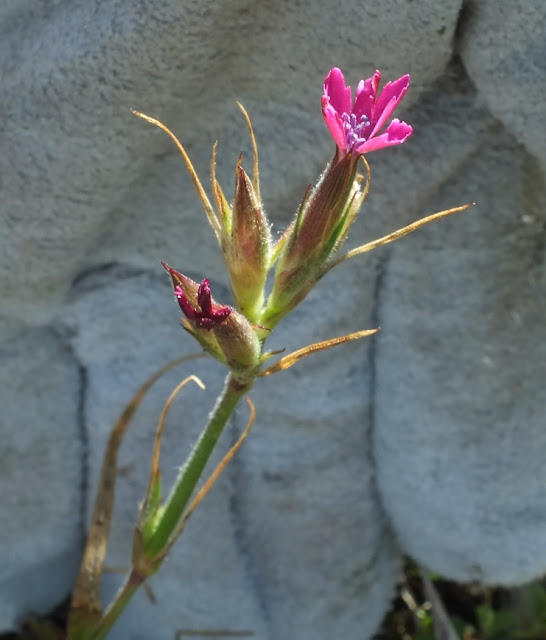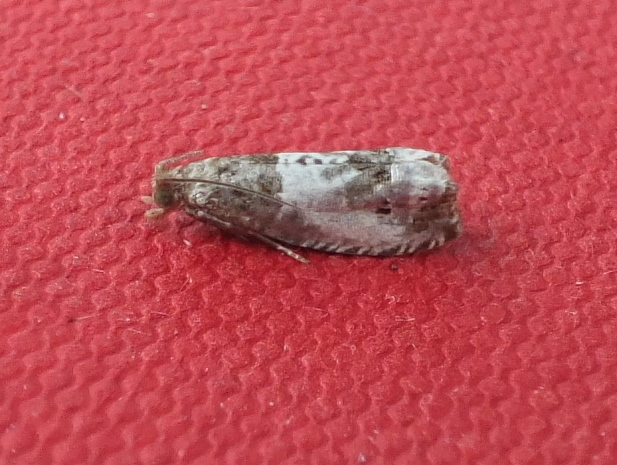The Safari has a couple of odds n sods for you from yesterday. While sat out in the garden at Base Camp waiting to go to see the doc we has a Holly Blue flutter by and what looked like a Green Veined White too.
But it was Frank's last venture outside before bed time that gave us the 'sighting' of the day; we heard the shrill calls of a Dunlin (Garden #34) flying overhead in the darkness while we were stood at the front door.
Today we were unable to get an early morning look at Patch 2 and conditions weren't too bad after he wind had dropped overnight, we were pretty peeved to say the least. Further up the coast SMcC was doing a four hour NWDW and we had hoped to be able to nip up and join her for a short while but everything conspired against us today and we weren't able to. We did get txts sating she'd had a Harbour Porpoise and a Grey Seal followed later by another Harbopur Porpoise and later almost at the end of her session two more feeding together, four Harbour Porpoises in one watch is impressive for this coast!
We got out for our hour at lunchtime but were joined by no volunteers today. Our notebook stayed empty until we too found a Grey Seal and it was a while more before we found a distant flock of about 80 Common Scoters bobbing on the swell, several other flocks in flight were seen taking us to about 150. An adult Gannet cruised past in the haze but an immature stayed to fish for some time. It circled round very low over the water before sliding in at a very acute angle, the fish must have been almost at the surface. Nearby a dark blog kept appearing and diappearing it took a while but eventually gave itself up as another Grey Seal.
A few small flocks of Dunlin whizzed past as did two Sandwich Terns and that was about the sum total of our hour's watch although there were good numbers of gulls on the beach today for the first time this season - best not tell the 'authorities'! having said that if a Bottle Nosed Dolphin weighs 300x what a Herring Gull does then it must do 300x the amount of you know what, so will the 'authorities' be wanting to ban the dolphins too? And then there's all those fish the dolphins are eating they must be sh*tting in our bathing water as well - yuk yuk and double yuk; time for a ban on fish in the sea too?
Whilst on the subject of bans here's lovely pic of a somewhat scarce caterpillar in our neck of the woods this year. A rugby jersey wearing Cinnabar moth caterpillar chomping away on the ridiculously poisonous and consequently loathed Ragwort. Sometimes we think we'd get less hostile comments from the passer's-by if we grew Cannabis rather than this fantastic wildlife attractor. It's absolutely buzzing at the mo with all manner of invertebrates.
We know it is a good looking plant very attractive to wildlife and we recognise that it's poisonous to horses and other livestock but there's not many of them in our work's garden and it's not going to be cut for hay. We can understand the fear it probably brought in times gone by when heavy horses were the mainstay of agriculture but now it's mainly 'only' (prepare to get shot down in flames - sorry ST) pets at risk. Very expensive pets yes but not essential working animals which were fed on hay. We often drive past the horsey areas and see Ragwort in the paddocks where, to our ecological eye, it does no harm, the horses eat round it, but is a sign of poor paddock management including over grazing and/or over-stocking resulting in poaching and providing bare ground on which the seeds can germinate. A tight sward meadow with little bare ground is a hostile place for Ragwort to get established hence it's rarity in good quality hay meadows.
Which brings us on to another rant topic - wildflowers in general and the current woeful ignorance by almost all of the public about them and the corresponding wanton vandalism to them by gardeners, landscape technicians, highway verge mowing people etc etc. For almost every wildflower there is something that looks similar in the garden centre or nursery and yet we have to pay good money for those when we could have the real thing for free - why? If you do go the the garden centre spend time watching which plants the insects are visiting and choose those, the chances are the others are sterile and offer no pollen or nectar to hungry bees, butterddflies etc.
We think that the disconnection from wildflowers is nothing to do with their beauty, or even perceived lack of it, but the fact we haven't put our hand in our pocket to pay for them. We haven't given them a monetary value therefore they are totally valueless. A chap near Base Camp has planted Primulas and Marguerites around the base of one of our new street trees and the mowing team happily avoid them, we can almost guarantee that if we did the same with cowslips and Ox-eye Daisies they'd be mown or sprayed within days! Might try it next year and out a stopwatch to them.
Another case in point is a grass verge near the hosp[ital, or two actually. One was festooned with Rough (or Autumn) Hawkbit last week and the other smaller area was a sea of yellow Bird's Foot Trefoil and blue Self Heal, both absolutely beautiful and no doubt crawling with bees, butterflies, hoverflies etc and neither more than two or three inches long, the hawkbit area you could walk through but the other was a steep bank no-one ever sets foot on. We drove past the other evening and both had been wantonly vandalised by the mowing machine scalped to the bone dry roots - why? In the name of 'tidiness' that's why!!! A total waste of time, money and more importantly biodiversity!
Now if very similar looking but useless biologically plants had been bought and time and money spent on preparing the ground and planting them a foot apart with lots of bare soil around them it would be called a flower-bed and would be lovingly tended at excessive cost in £££ and (wo)manpower, but because the wild plants are 'free' and don't grow in straight lines AND have the audacity to grow through/amongst the grass (all hail to the grass!!!) they've somehow become worse than worthless and still need £££ and lots of manpower to get rid of them when really they could easily be kept and enjoyed, not just be the other humans but a multitude of pollinators we're supposed to be enlightened enough to want to protect and encourage these days, indeed we NEED to do that - not much sign of that on the scalped greenery here though.
Rant over...
Where to next? Another short hours NWDW tomorrow lunchime then we'll be on the beach with a gang of youngsters celebrating National Marine Week even though we're not part of the Wildlife Trusts - they are our chums though.
In the meantime let us know who's been let lose with the poer tools in your outback - and that's another thing all this power assisted stuff makes the destruction all too easy. If lawns/hedges/trees etc had to be 'kept in check' with a hand tool much more would survive...what is it about the must keep in check? It's hardly going to go for our throats is it...now maybe if we still had big Brown Bears (if only - sigh) they just might once in a while.
PS that load odf twaddle was our 1500th blogpost - if you've read every word well done and God help you, hope you 'enjoy' the next 1500.
PS that load odf twaddle was our 1500th blogpost - if you've read every word well done and God help you, hope you 'enjoy' the next 1500.



























































